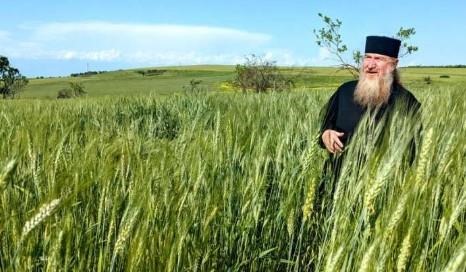By Susan Kelley
Morgan Ruelle was living in the remote mountains of Ethiopia in 2011, researching his dissertation on food diversity, when he kept hearing about a crop that confused him.

Nikoloz Lomsadze, senior pastor of a church in Dedoflis Tskaro, in eastern Republic of Georgia, looks over his field of mixed barley and wheat. He uses the mixture to make holy sacrament and church feasts.
The farmers repeatedly mentioned a grain called "duragna" in Amharic that had no equivalent in English. "They kept saying, 'Well, it's not really wheat, it's not really barley,'" Ruelle says. "I was just kind of stumped by it for several weeks."
Eventually a farmer explained that duragna was actually a mix of both wheat and barley, and sometimes other grains too, planted together, rather than one type of grain sown in orderly rows.
He had stumbled upon one of the few places in the world where farmers still sow maslins, or cereal species mixtures, which can contain rice, millet, wheat, rye, barley, triticale, emmer and more.
The knowledge the farmers shared with Ruelle led to a paper by current and former Cornell researchers that suggests maslins, which have fed humans for millennia but now are largely forgotten, have the unique capacity to adapt in real time to increasingly unpredictable and extreme weather caused by climate change.
The research braids together previous work in agronomy, ethnography, archeology, history and ecology. It shows maslins—from a Latin word for "mixed"—have been used for more than 3,000 years and in at least 27 countries, from northern Africa to Europe and Asia and later North America. Wild maslins may have even given rise to agriculture.
"Subsistence farmers around the world have been managing and mitigating risk on their farms for thousands and thousands of years and have developed these locally adapted strategies to do that," says former Cornell postdoctoral researcher Alex McAlvay, the paper's first author and now a researcher at the New York Botanical Garden. "There's a lot we could learn from them, especially now, in a time of climate change."
More rapid than evolution
At first, Ruelle—now an assistant professor of environmental science and policy at Clark University—thought farmers were growing maslins together, and then separating the components during the harvest—easy enough with other mixed plantings like fava beans, which grow tall, and low-growing field peas. But wheat and barley? "I couldn't imagine them going through the field and saying, this is wheat, this is barley. That just seemed very difficult."
Then he began to realize why farmers think of the mixture as a single crop. Women began telling him they use it to make bread, beer, injera—a sourdough pancake—and kollo, a popular snack of roasted cereals, legumes and oilseeds. The wheat and barley are planted together, harvested together, prepared and consumed together.
"Right away we were thinking, the proportions [of wheat and barley] must change year to year," Ruelle says. "It's this continuously evolving responsive entity. On its own, it's operating outside the farmer's control to respond to whatever conditions happen."
For example, if an unusually heavy rain destroys half the plants, the plants that are still standing are well adapted to that rain event, says Anna DiPaola, a doctoral student and a co-author of the paper. "Nature is giving the farmer feedback and saying, 'This is well-adapted. Plant this again.'"
And if a drought makes it a bad year for wheat, barley, which tends to be more drought resistant, will compensate and produce a better yield, Ruelle says. "So no matter what, you're going to be able to make bread with this."
McAlvay found farmers extoling that benefit during research in the country of Georgia. On their first field trip there, in summer 2022, he talked with a priest who was growing a mixture of wheat and barley, which he uses for holy sacraments and church feasts. "He said, 'If one fails, at least we have the other.' The translator used the exact same words that the translator in Ethiopia had used. I thought, 'Wow, this is a phenomenon,'" McAlvay says.
The proportions in the mixtures shift from year to year, automatically adapting to the growing conditions at hand. If an area is getting increasingly drier, the wheat won't grow as well, and the seed the farmer saves for the next planting will automatically include less wheat and more barley, McAlvay says.
Click here to see more...